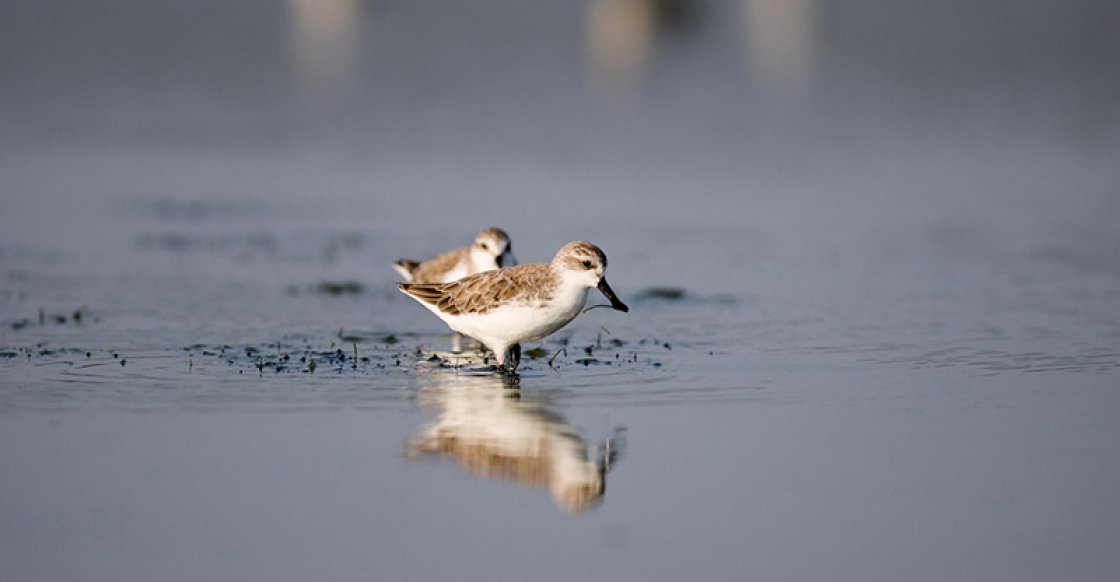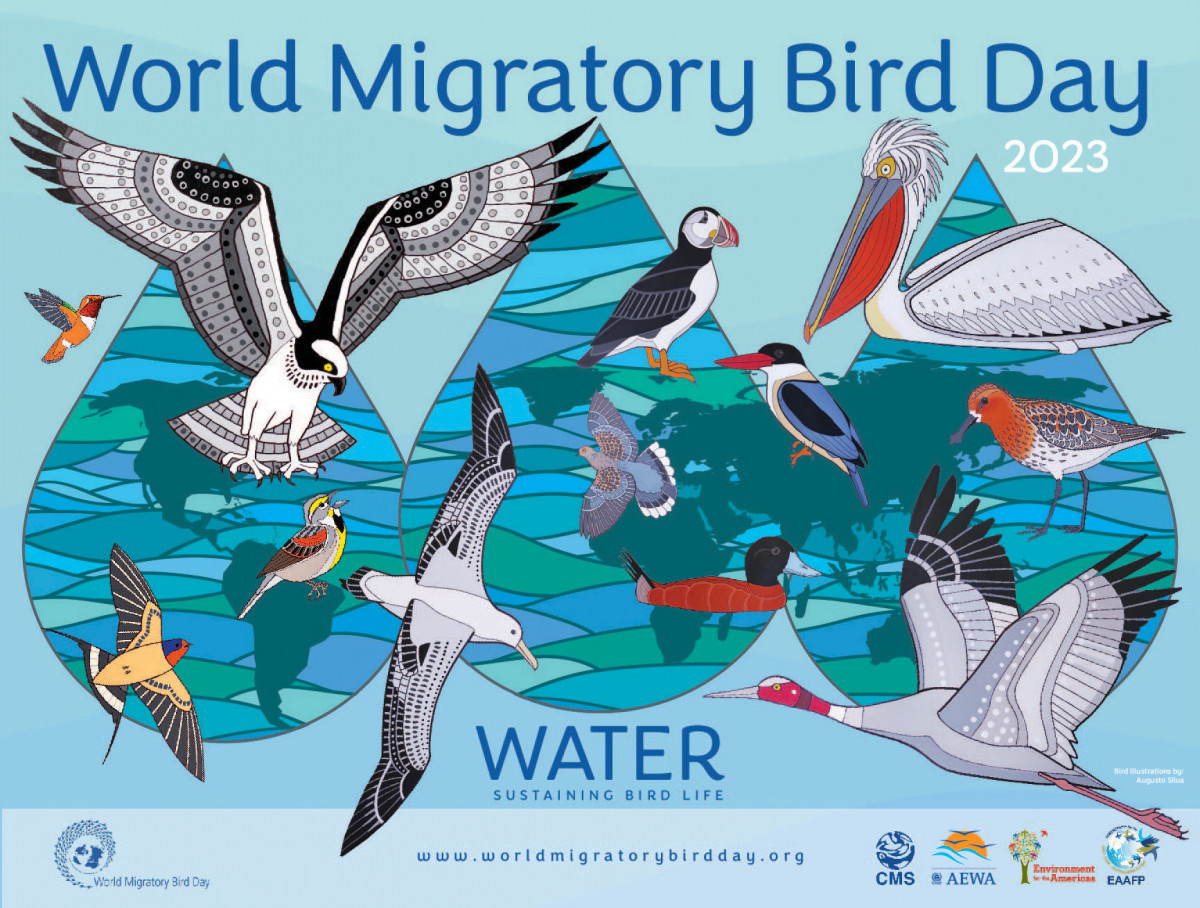You are here
PRESS RELEASE: Global Campaign Highlights Importance of Water for Migratory Birds

BONN/BOULDER/ INCHEON, 12 October 2023 – World Migratory Bird Day 2023 is here, focusing on the theme "Water: Sustaining Bird Life." On October 14th, people and organizations all over the world will come together to raise awareness and take action.
Water is essential to the survival of migratory birds. From breeding to resting, and refueling during migration and wintering, migratory birds rely on lakes, rivers, ponds, coastal wetlands, and even moisture found in seeds, flowers, and mist. But water is under threat. Climate change, pollution, and increasing human demand for water are endangering vital ecosystems and the availability of clean water – for birds and people alike. In fact, 35 percent of the world's wetlands have been lost in the last 50 years, and the recently published UN World Water Report estimates that over 2 billion people now don’t have access to safe drinking water.
It's not just water quality that's at risk, but also quantity. Lake Chad, a Ramsar site and one of the largest water bodies in Africa in 1960, lost 90 % of its area, depleting water resources for local communities and also for many migratory birds. In the Amur-Heilong Basin in Asia, climate change is exacerbating habitat destruction, leaving migratory birds without crucial breeding and stopover sites. In the United States, extended drought has left some wetlands, such as Cheyenne Bottoms in Kansas, dry during migration, impacting shorebirds and other species. The facts are alarming: 48 percent of existing bird species worldwide are experiencing population declines.
World Migratory Bird Day serves as a global call to action. With migratory birds crossing the borders of multiple countries, international cooperation is crucial for their effective conservation. Only by acting together can the global water crisis be addressed and our shared birds be effectively conserved.
The campaign is organized by the Convention on the Conservation of Migratory Species of Wild Animals (CMS), the African-Eurasian Migratory Waterbird Agreement (AEWA), Environment for the Americas (EFTA), and the East Asian-Australasian Flyway Partnership (EAAFP). Various events are scheduled for October 14th, including an educational event along the Kherlen River in Mongolia, a bird conservation festival in Bangladesh, a festival in Guatemala, zoo events in Belize, and many more worldwide.
Learn more and take part in this important campaign by visiting www.worldmigratorybirdday.org and discover how you can participate and make a difference. Help us ensure a brighter future for migratory birds and the precious water they depend on.
Quotes
Convention on Migratory Species (CMS)
“Water is essential for people as well as for migratory birds and other wild species of animals. Yet around the world, the availability and quality of water is under enormous pressure, with deeply concerning implications. The looming global water crisis requires urgent action by governments, businesses, local communities as well as individuals. Because migratory birds cross national borders and even continents, international cooperation is essential to ensure that actions are taken to conserve and restore important habitats for migratory birds, and to address the drivers of water loss, pollution, and climate change,” said Amy Fraenkel, Executive Secretary of the Convention on the Conservation of Migratory Species of Wild Animals (CMS).
African-Eurasian Migratory Waterbird Agreement (AEWA)
“The water crisis highlighted by the UN 2023 Water Conference has a tremendous impact on migratory birds. In the Sahel in particular, many wetlands on which migratory waterbirds rely during the non-breeding period are shrinking. Water is a vital resource for all, local communities as well as birds. By reducing our consumption, combatting climate change, and managing wetlands wiser, we can improve the situation,” said Dr. Jacques Trouvilliez, Executive Secretary of the Agreement on the Conservation of African-Eurasian Migratory Waterbirds (AEWA).
Environment for the Americas (EFTA)
“World Migratory Bird Day 2023 spotlights the vital role that water plays in the survival of our shared birds. The focal species illustrated on the campaign poster depict the intricate bond each bird shares with water. The diminutive Rufous Hummingbird thrives on nectar-producing flowers that rely on water for their blooms, and the Dickcissel scours the grasslands for seeds that hold the moisture they need. White Pelicans and Ospreys seek their prey in freshwater lakes, while the magnificent Wandering Albatross and Atlantic Puffin remain at sea. WMBD is an opportunity to unify our voices for the conservation of migratory birds and to celebrate their spectacular journeys,” said Dr. Susan Bonfield, Executive Director at Environment for the Americas (EFTA).
East Asian-Australasian Flyway Partnership (EAAFP)
“Water is life. Protecting this precious resource for migratory waterbirds can make the difference between life and death for a whole species. Consider the amazing little Spoon-billed Sandpiper with a global population estimated between 360 – 600. At 15 centimetres long, about the size of a sparrow, it travels back and forth across the length of Asia to feed, rest and breed. Its small beak shaped exactly like a spoon sifts through mud and sand in shallow water to gather the worms and shrimps it eats. Water quality determines the quality of this food — pesticides, unsustainable agriculture, microplastics in their foodchain are unhealthy for both them and us. So let’s protect our water, to protect us all,” said Jennifer George, Chief Executive at the East Asian-Australasian Flyway Partnership (EAAFP).
Notes to Editors:
About the Convention on Migratory Species (CMS)
The Convention on the Conservation of Migratory Species of Wild Animals (CMS), a global treaty of the United Nations, provides a global platform for the conservation and sustainable use of migratory animals and their habitats. This unique treaty brings governments and wildlife experts together to address the conservation needs of terrestrial, aquatic, and avian migratory species and their habitats around the world. Since the Convention's entry into force in 1979, its membership has grown steadily to include 133 Parties from Africa, Central and South America, Asia, Europe, and Oceania. Learn more at www.cms.int
About the Agreement on the Conservation of African-Eurasian Migratory Waterbirds (AEWA)
The Agreement on the Conservation of African-Eurasian Migratory Waterbirds (AEWA) is an inter-governmental treaty dedicated to the conservation of migratory waterbirds that migrate along the African-Eurasian Flyway. The Agreement covers 255 species of birds ecologically dependent on wetlands for at least part of their annual cycle. A total of 83 countries and the European Union have signed the environmental treaty, which has a geographic range covering 119 countries across Africa, Europe, the Middle East, Central Asia, Greenland, and the Canadian Archipelago. Learn more at www.unep-aewa.org
About Environment for the Americas (EFTA)
Environment for the Americas connects people to nature and birds through research, education, and outreach. At the heart of our efforts lies the coordination of World Migratory Bird Day across the Americas, an initiative that engages people of all ages in the protection of our shared migratory birds. This work has also led to the development of our internship programs, which provide unique opportunities for the next generation of researchers, conservationists, and natural resource professionals. Through these programs, we are empowering young people to make a tangible difference for the environment. EFTA’s efforts have also spurred international collaborations for bird conservation and facilitated changes across borders that ensure a future where migratory birds are protected and celebrated. Learn more at www.environmentamericas.org
About the East Asian-Australasian Flyway Partnership (EAAFP)
The East Asian-Australasian Flyway Partnership (EAAFP) is a flyway-wide framework to promote dialogue, cooperation, and collaboration between a range of stakeholders to conserve migratory waterbirds and their habitats. EAAFP is also recognized as one of the Ramsar Regional Initiatives in 2005 and officially launched on 6 November 2006. With the 40 partners, the partnership aims to protect migratory waterbirds, their habitats, and the livelihoods of people dependent upon them in the East Asian-Australasian Flyway. For more information, visit www.eaaflyway.net
Related Links:
World Migratory Bird Day Website: www.worldmigratorybirdday.org
Social Media Trello Board: www.worldmigratorybirdday.org/2023/resources
Global Event Map: www.worldmigratorybirdday.org/events-map
Social Media:
Facebook: WorldMigratoryBirdDay
Instagram: @worldmigratorybirdday
Twitter: @WMBD
#WorldMigratoryBirdDay
#WMBD2023
#WaterForBirds
For more information and expert interviews, please contact:
Florian Keil, Information Officer / Coordinator of the World Migratory Bird Day Campaign at the CMS and AEWA Secretariats, Tel: +49 (0) 228 8152451, [email protected]
Susan Bonfield, Executive Director at Environment for the Americas, Tel: +001 970-393-1183, [email protected]
Wen Qing Ng, Communications Officer at the East Asian-Australasian Partnership, Tel: +82 010 032 458 6504, [email protected]

